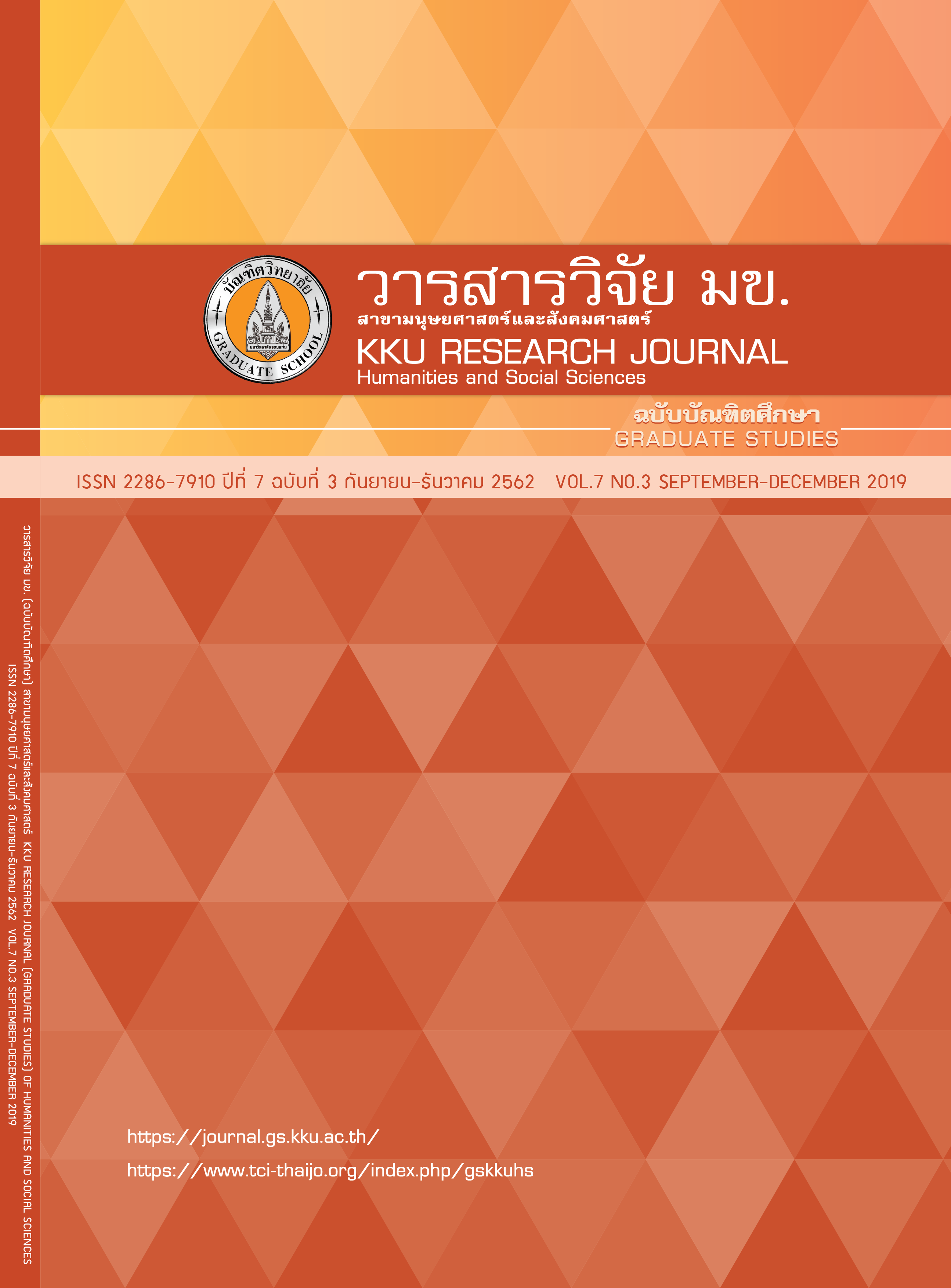การสร้างมูลค่าเพิ่มจากภูมิปัญญาผ้าขาวม้าในจังหวัดเลยสู่เศรษฐกิจสร้างสรรค์
คำสำคัญ:
การสร้างมูลค่าเพิ่ม, การออกแบบลายผ้า, การแปรรูปบทคัดย่อ
การวิจัยครั้งนี้มีวัตถุประสงค์เพื่อสร้างมูลค่าเพิ่มของผลิตภัณฑ์ผ้าขาวม้าในกลุ่มผ้าทอบ้านกำเนิดเพชร จังหวัดเลย ในด้านรูปแบบ ลวดลายและการแปรรูปผ้าขาวม้า โดยใช้วิธีการวิจัยเชิงปฏิบัติการแบบมีส่วนร่วม ผสมผสานทั้งเชิงปริมาณและเชิงคุณภาพ การวิจัยเชิงปริมาณกลุ่มตัวอย่างคือ ผู้บริโภคผ้าทอพื้นบ้าน เพื่อวิเคราะห์ความต้องการของผู้บริโภค ส่วนเชิงคุณภาพกลุ่มเป้าหมายประกอบด้วย สมาชิกในกลุ่มผ้าทอบ้านกำเนิดเพชร สมาชิกใน เครื่องมือที่ใช้ในการวิจัย คือ แบบสอบถาม แนวสัมภาษณ์เชิงลึก และ ประเด็นสนทนากลุ่ม วิธีการตรวจสอบข้อมูลเชิงคุณภาพ ใช้เทคนิคสามเส้า การวิเคราะห์ข้อมูลเชิงปริมาณ โดยใช้สถิติพื้นฐาน ร้อยละ ความถี่ ส่วนเชิงคุณภาพโดยวิธีการวิเคราะห์เนื้อหา (Content Analysis) ผลการวิจัยพบว่าการสร้างมูลค่าเพิ่มของผลิตภัณฑ์ผ้าทอในกลุ่มผ้าขาวม้า โดยการออกแบบลายผ้าขาวม้าคือลายเพชรน้ำพาวที่เป็นสัญลักษณ์ของชุมชน ส่วนการแปรรูปผ้าทอได้ผลิตภัณฑ์ดังนี้ (1) เครื่องแต่งกาย (2) ของใช้ในบ้าน โรงแรม และสำนักงาน (3) ของใช้บนโต๊ะอาหาร (4) ของตกแต่งบ้าน โรงแรม และสำนักงาน และ (5) ของฝาก ของที่ระลึก การทำบรรจุภัณฑ์โดยออกแบบเป็นกล่องพลาสติกใสรูปร่างสี่เหลี่ยม
เอกสารอ้างอิง
from https://channarongs22.wordpress.com
2. Loincloth [Internet] 2017. Retrieved June, 2017,
from www.mblog.manager.co.th
3. Watanyu S. Problems of Local Woven Fabric in Loei Province,
Chief of Community Development Loei Province Office.
Interview (5 August, 2017).
4. Nirun Y. The Value of Local Lincloth Poducts in the Thee Aeas of
Eonomic Coperation. Master Thesis Mahidol University; 2010.
5. Kittisak P. Principles of Qality Cntrol. Bangkok: Thai-Japanese
Association for Technology Promotion; 2007.
6. Witchakon J. Folk Txtile Research. Bangkok: Thailand Research
Fund; 2007.
7. Piyamaporn R. Study and Development of Local Weaving Patterns
for Product Design. Master Thesis King Mongkut's Institute of
Technology Ladkrabang; 2008.
8. Thitima B, Jaratpim W. Design and Development of Clothing
from Native Thai Black Fabric, Khao Yoi District, Phetchaburi
Province. Bangkok: Rajamangala University of Technology
Phra Nakhon; 2013.
9. Jaraspim W, et al. The Development of Loincloth Products Using
the Concept of Local Wisdom and Fashion Design for Professional
Development and Community Products Wanonnivat District
Sakonnakonn Province. Bangkok: Faculty of Textile Industry and
Fashion Design Rajamangala University of Technology
Phra Nakhon; 2013.
10. Supachai S et al. The Development of Folk Textile Products.
A Case Study of Ban Praewar Sahatsakan District Kalasin Province.
Bangkok: Thailand Research Fund; 2005.
11. Sakul W. Community Textile Potential Development in Chaiyaphum
Province. Bangkok: Thailand Research Fund; 2010.
12. Piyathida S. Development of Artificial Flower Fabric from Loincloth.
Bangkok: Faculty of Textile Industry and Fashion Design Rajamangala
University of Technology Phra Nakhon; 2016.
13. Kanchana D et al. Study on the Product Development Pattern of
Loincloth. at Ban Khok Kloi to Seek the Market and Promote the Role
of Women. Bangkok: Thailand Research Fund; 2011.




